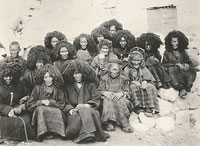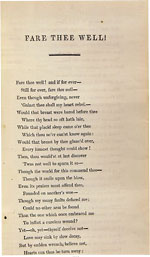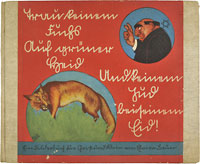Big Fish
India and Beyond
Album of photographs of Tibet by John Claude White, £38,400 ($60,695) at Bonhams in London on October 5.
The extraordinary hair-dos seen in this photograph belong to a group of Tibetan nuns and the photograph is one of seventy platinum prints and two folding panoramas that make up an album compiled by a political officer attached to the British Tibet Mission of 1903-04 led by Sir Francis Younghusband. That expedition that was supposedly intended to settle border disputes between Sikkim and Tibet but in practice resembled a military invasion and occupation. The album was part of an ‘India & Beyond’ sale that included books and maps but mostly photographs.
In 1908, Johnston & Hoffman of Calcutta published a now very rare oblong quarto collection of White’s photographs in a two-volume work called simply Tibet and Lhasa. In the last twenty or so years, just four copies of the first volume, containing fifty-three photographic plates, have come to auction—the most recent being that sold by Lawrences of Crewkerne for £6,000 ($9,855) on July 5 of this year—but only two examples of the complete work, which runs to eighty-three plates, are recorded at auction.
In 1979 one set sold at Sotheby’s New York for $18,150 and in 2000, in the same rooms, another was sold at a whopping $105,000. It could have been the same set, I suppose, but if so, then by the time it came back to auction, three multi-paneled panoramas had been removed and framed.
Byron Says Goodbye to the Wife
Fare Thee Well! (and Hours of Idleness) by Lord Byron, £26,840 ($41,480) at Bloomsbury Auctions in London on September 14.
Bound after an 1807 first issue of Hours of Idleness, which itself is only Byron’s second published work, the poem Fare thee Well! is a legendary Byron rarity and one of just fifty copies that were privately printed and distributed by publisher John Murray in April 1816.
One of Byron’s two “separation” poems, and described by one biographer, Peter Quennell, as “a somewhat maudlin apostrophe to the faultless but unforgiving wife,” it gained much wider distribution than had been intended and caused a great deal of hurt all round when a copy somehow (and probably mischievously) fell into newspaper hands and was published in the Morning Chronicle—but those original copies are very rare indeed.
The literary scholar, editor, bibliographer, collector, and forger Thomas J. Wise, in his 1928 bibliography of Byron’s works, described it as “practically impossible to acquire” and said he knew of only three or four copies. In this instance he was not priming the market for one of his clever forgeries, but noting real rarity.
In the past thirty or so years only two other copies have come to auction. In 1979 a copy bound up with an 1817 copy of The Lament of Tasso sold at £2,530 (then $5,200) at Phillips on London and in 1993 another sold for £7,475 (then around $11,000) as a single folded sheet at Sotheby’s.
Teach Yourself Ant-Semitism
Trau Keinem Fuchs auf Grüner Heid und Keinem Jüd bei Seinem Eid by Elvira Bauer, £940 ($1,490) at Dominic Winter of South Cerney on September 29-30.
Something particularly unpleasant from the years of the Nazi party’s rise to power, this child’s guide to anti-Semitism takes as its title a phrase once used by Martin Luther, “Trust No Fox on his Green Heath and no Jew on his Oath.”
Produced by the former schoolteacher and Nazi stalwart Julius Streicher, the publisher of a virulently anti-Jewish newspaper called Der Stürmer [Stormtrooper], it contains twenty-one colored illustrations and verses. The work of an eighteen-year-old art student, Elvira Bauer, it was first published in 1936, and depending on which sources you consult, either went into several editions and/or was printed in around 100,000 copies for distribution in German schools. This example was billed as a first in the original pictorial binding.
You can find the whole unpleasant thing, pictures and verses together, online, if you wish, but beware of straying onto sites on which it is not regarded as deplorable, but something quite laudable.








 Ian McKay’s weekly column in Antiques Trade Gazette has been running for more than 30 years.
Ian McKay’s weekly column in Antiques Trade Gazette has been running for more than 30 years.


